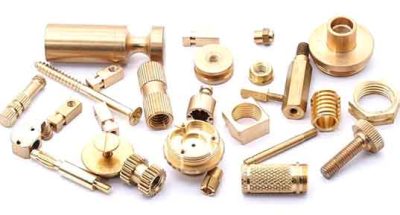Obrábanie zliatin medi (sústruženie, frézovanie) má vynikajúci výkon a nízky odpor. Dobrá ťažnosť, vysoká tepelná a elektrická vodivosť, takže je to najbežnejšie používaný materiál v kábloch, konektory, a elektrické a elektronické komponenty. Môže byť tiež použitý ako stavebný materiál a môže byť zložený z mnohých druhov zliatin. Najdôležitejšie z nich sú: berýliová meď, fosforový bronz, bronz a mosadz. Navyše, meď je tiež odolný kov, ktorý je možné mnohokrát recyklovať bez toho, aby sa znížila jeho výkonnosť pri mechanickom sústružení a frézovaní.
The cutting amount of CNC turning copper parts is 3-4 mm, the feed is 0.25, and the speed is determined according to the diameter.
1. The spindle speed of the CNC lathe is determined according to the material of the workpiece and the material of the tool. Vo všeobecnosti, the higher the speed, the better the finish; The faster the feed speed, the faster the processing speed; The greater the turning depth, the higher the processing speed.
2. Vo všeobecnosti, the high turning speed is not suitable for large turning thickness, and larger feed can be selected. The medium and low speeds make the machine tool have larger torque, which is suitable for large turning thickness, and the feed should not be too fast. If the feed is large, the turning thickness should be small. These are all related to the rigidity of the machine tool, the cutting tool, and the properties of the copper metal material.
3. The rough processing of copper generally focuses on improving productivity, but economy and processing costs should also be considered; When semi-finishing and finishing, the turning efficiency, economy and processing cost should be taken into consideration on the premise of ensuring the processing quality.
4. The feed amount is: the relative displacement of the workpiece and the tool in the direction of the feed movement when the workpiece or tool rotates one circle or reciprocating once or the tool rotates one tooth.
 Copper turning parts |
Copper inserts, hexagonal copper inserts. It is made by direct turning with hexagonal bar, the process is simple, it is firm and not easy to rotate after being injected into the plastic as an insert, and has good engineering performance. The picture on the left is: M6 copper H10 opposite sides of the insert, M5 copper H8 opposite sides of the insert, made of copper C3604. Hexagonal plastic copper insert for implantation, which is injected into the plastic as an insert Available specifications: M2-12. |
 Elektronické medené diely |
Las tuercas de inserción de cobre hexagonales más utilizadas La imagen de la izquierda es una de las inserciones de cobre hexagonales más comúnmente utilizados con un simple y estructura práctica. La ranura del medio se fabrica con una barra hexagonal y la rosca interior está roscada y biselada. La eficiencia de producción es alta y el costo es relativamente bajo. Aplicación: La tuerca de inserción de cobre se inyecta en la pieza de plástico mediante inyección de molde, lo que tiene un rendimiento anti-aflojamiento confiable. Las especificaciones del inserto de cobre hexagonal en la imagen de la izquierda: M5 * H8 * 10, Puede producir especificaciones: M2 ~ M12, la longitud de los lados opuestos no está limitada El material de inserción de cobre en la imagen de la izquierda: latón C3604, Materiales disponibles: cobre, acero inoxidable y acero de corte libre Haga clic en la imagen de la izquierda para ver el inserto de cobre hexagonal de la imagen más grande |
 Machining copper nuts |
The main use of hexagon side H4 than copper insert part is a plastic member injection molded product. After installation, an effective internal thread can be formed in the plastic part. The method of operation is to directly use mold injection, because brass has good thermal conductivity, and the molded plastic parts and copper embedded parts have a good combination. The picture on the left shows copper inlaid parts of specifications M4 and M6. |
 English
English العربية
العربية 中文(漢字)
中文(漢字) Čeština
Čeština Dansk
Dansk Nederlands
Nederlands Suomi
Suomi Français
Français Deutsch
Deutsch Italiano
Italiano 日本語
日本語 ಕನ್ನಡ
ಕನ್ನಡ 한국어
한국어 Português
Português Русский
Русский Slovenčina
Slovenčina Español
Español Svenska
Svenska Türkçe
Türkçe

